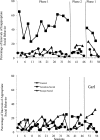Functional analysis of inappropriate social interactions in students with Asperger's syndrome
- PMID: 23060671
- PMCID: PMC3469297
- DOI: 10.1901/jaba.2012.45-585
Functional analysis of inappropriate social interactions in students with Asperger's syndrome
Abstract
We analyzed the inappropriate social interactions of 3 students with Asperger's syndrome whose behavior was maintained by social positive reinforcement. We tested whether inappropriate social behavior was sensitive to social positive reinforcement contingencies and whether such contingencies could be reversed to increase the probability of socially appropriate responding. Our results show that social positive reinforcers can be identified for inappropriate social interactions and that appropriate social behaviors can be sensitive to reinforcement contingency reversals.
Keywords: Asperger's syndrome; autism spectrum disorder; functional analysis; social interaction; social skills.
Figures



References
-
- American Psychiatric Association. Diagnostic and statistical manual of mental disorders (4th ed.) Washington, DC: Author; 1994.
-
- Davison M, McCarthy D. The matching law: A research review. Hillsdale, NJ: Erlbaum; 1988.
-
- Fombonne E. Epidemiology of pervasive developmental disorders. Pediatric Research. 2009;65:591–598. - PubMed
-
- Kennedy C. H. Research on social relationships. In: Emerson E, Hatton C, Paramenter T, Thompson T, editors. International handbook of applied research in intellectual disabilities. London, UK: Wiley; 2004. pp. 297–310. In. (Eds.) pp.
Publication types
MeSH terms
Grants and funding
LinkOut - more resources
Full Text Sources
Medical

